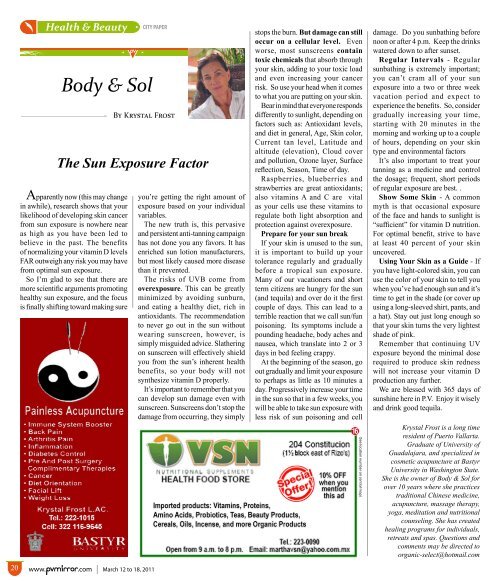You also want an ePaper? Increase the reach of your titles
YUMPU automatically turns print PDFs into web optimized ePapers that Google loves.
Health & Beauty<br />
Body & Sol<br />
By Krystal Frost<br />
The Sun Exposure Factor<br />
Apparently now (this may change<br />
in awhile), research shows that your<br />
likelihood of developing skin cancer<br />
from sun exposure is nowhere near<br />
as high as you have been led to<br />
believe in the past. The benefits<br />
of normalizing your vitamin D levels<br />
FAR outweigh any risk you may have<br />
from optimal sun exposure.<br />
So I’m glad to see that there are<br />
more scientific arguments promoting<br />
healthy sun exposure, and the focus<br />
is finally shifting toward making sure<br />
20 www. .<strong>com</strong> March 12 to 18, 2011<br />
you’re getting the right amount of<br />
exposure based on your individual<br />
variables.<br />
The new truth is, this pervasive<br />
and persistent anti-tanning campaign<br />
has not done you any favors. It has<br />
enriched sun lotion manufacturers,<br />
but most likely caused more disease<br />
than it prevented.<br />
The risks of UVB <strong>com</strong>e from<br />
overexposure. This can be greatly<br />
minimized by avoiding sunburn,<br />
and eating a healthy diet, rich in<br />
antioxidants. The re<strong>com</strong>mendation<br />
to never go out in the sun without<br />
wearing sunscreen, however, is<br />
simply misguided advice. Slathering<br />
on sunscreen will effectively shield<br />
you from the sun’s inherent health<br />
benefits, so your body will not<br />
synthesize vitamin D properly.<br />
It’s important to remember that you<br />
can develop sun damage even with<br />
sunscreen. Sunscreens don’t stop the<br />
damage from occurring, they simply<br />
stops the burn. But damage can still<br />
occur on a cellular level. Even<br />
worse, most sunscreens contain<br />
toxic chemicals that absorb through<br />
your skin, adding to your toxic load<br />
and even increasing your cancer<br />
risk. So use your head when it <strong>com</strong>es<br />
to what you are putting on your skin.<br />
Bear in mind that everyone responds<br />
differently to sunlight, depending on<br />
factors such as: Antioxidant levels,<br />
and diet in general, Age, Skin color,<br />
Current tan level, Latitude and<br />
altitude (elevation), Cloud cover<br />
and pollution, Ozone layer, Surface<br />
reflection, Season, Time of day.<br />
Raspberries, blueberries and<br />
strawberries are great antioxidants;<br />
also vitamins A and C are vital<br />
as your cells use these vitamins to<br />
regulate both light absorption and<br />
protection against overexposure.<br />
Prepare for your sun break<br />
If your skin is unused to the sun,<br />
it is important to build up your<br />
tolerance regularly and gradually<br />
before a tropical sun exposure.<br />
Many of our vacationers and short<br />
term citizens are hungry for the sun<br />
(and tequila) and over do it the first<br />
couple of days. This can lead to a<br />
terrible reaction that we call sun/fun<br />
poisoning. Its symptoms include a<br />
pounding headache, body aches and<br />
nausea, which translate into 2 or 3<br />
days in bed feeling crappy.<br />
At the beginning of the season, go<br />
out gradually and limit your exposure<br />
to perhaps as little as 10 minutes a<br />
day. Progressively increase your time<br />
in the sun so that in a few weeks, you<br />
will be able to take sun exposure with<br />
less risk of sun poisoning and cell<br />
(See location number on central map)<br />
damage. Do you sunbathing before<br />
noon or after 4 p.m. Keep the drinks<br />
watered down to after sunset.<br />
Regular Intervals - Regular<br />
sunbathing is extremely important;<br />
you can’t cram all of your sun<br />
exposure into a two or three week<br />
vacation period and expect to<br />
experience the benefits. So, consider<br />
gradually increasing your time,<br />
starting with 20 minutes in the<br />
morning and working up to a couple<br />
of hours, depending on your skin<br />
type and environmental factors<br />
It’s also important to treat your<br />
tanning as a medicine and control<br />
the dosage; frequent, short periods<br />
of regular exposure are best. .<br />
Show Some Skin - A <strong>com</strong>mon<br />
myth is that occasional exposure<br />
of the face and hands to sunlight is<br />
“sufficient” for vitamin D nutrition.<br />
For optimal benefit, strive to have<br />
at least 40 percent of your skin<br />
uncovered.<br />
Using Your Skin as a Guide - If<br />
you have light-colored skin, you can<br />
use the color of your skin to tell you<br />
when you’ve had enough sun and it’s<br />
time to get in the shade (or cover up<br />
using a long-sleeved shirt, pants, and<br />
a hat). Stay out just long enough so<br />
that your skin turns the very lightest<br />
shade of pink.<br />
Remember that continuing UV<br />
exposure beyond the minimal dose<br />
required to produce skin redness<br />
will not increase your vitamin D<br />
production any further.<br />
We are blessed with 365 days of<br />
sunshine here in P.V. Enjoy it wisely<br />
and drink good tequila.<br />
Krystal Frost is a long time<br />
resident of Puerto Vallarta.<br />
Graduate of University of<br />
Guadalajara, and specialized in<br />
cosmetic acupuncture at Bastyr<br />
University in Washington State.<br />
She is the owner of Body & Sol for<br />
over 10 years where she practices<br />
traditional Chinese medicine,<br />
acupuncture, massage therapy,<br />
yoga, meditation and nutritional<br />
counseling. She has created<br />
healing programs for individuals,<br />
retreats and spas. Questions and<br />
<strong>com</strong>ments may be directed to<br />
organic-select@hotmail.<strong>com</strong>



